#gamelan of java
Explore tagged Tumblr posts
Text
Peni Candra Rini - Wani - you are unlikely to hear a better gamelan/rock crossover album than this one!
Peni Candra Rini (she/her), the Indonesian composer and performer whose musical practice encompasses a wide range of traditional and experimental Javanese styles mixed with western instrumentation, releases her second album of 2024. Wani is full of playful noise, rambunctious energy, and a deep sense of the unexpected. The album was created by giving the recorded musicians “very basic outlines” of the songs, improvising around those frameworks in the studio, and giving producers John Dieterich (Deerhoof, Mary Halvorson, Sufjan Stevens, Booker Stardrum) and Chris Botta (Yaeji, Emily Wells, the JACK Quartet, Valee, Shahzad Ismaily) “free reign to produce the tracks as they liked.” The result is a loud, fun, chaotic, energizing, and mesmerizing collection of songs that explore themes from traditional Javanese art, scripture, politics, shadow play, and song. Peni Candra Rini: voice Satomi Matzusaki: voice Jessica Zike: voice Andy McGraw: drums, pin-pia, percussion, cak, cuk, celeste, gamelan, harpsichord Hannah Standiford: cak Clover Dosier: cuk Robert Andrew Scott: fiddle Brian Larson: percussion Nat Quick: guitar, ukulele Gary Kalar: guitar Curt Sydnor: keyboards Brandon Simmons: flute John Priestley: bass, gongs Joanne Kong: harpsichord Putu Hiranmayena: gamelan I Gusti Putu Sudarta: voice Taylor Burton: gamelan Nicholas Merillat: gamelan Justin Alexander: drums Scott Clark: drums
11 notes
·
View notes
Text
Gua Tabuhan
Gua Tabuhan merupakan salah satu situs penting dalam sejarah peradaban manusia. Gua ini berada di daerah Pacitan, Jawa Timur. Menurut berbagai penelitian, gua ini dulunya merupakan tempat tinggal bagi manusia purba.
Keberadaan stalaktit dan stalagmit gua menjadi salah satu hal yang menarik, karena apabila dipukul akan menghasilkan nada. Bunyi nada itu menurut penduduk sekitar mirip dengan bunyi alat musik gamelan. Seniman daerah setempat memanfaatkan fenomena tersebut dengan memainkan tembang-tembang karawitan menggunakan stalaktit yang tumbuh alami di gua ini.
Setiap sudut gua memiliki karakteristik akustik yang unik. Kami mencoba melakukan serangkaian pengukuran dan percobaan untuk memahami bagaimana bunyi terpantul dan mengalir di dalam gua tersebut.
#gua#tabuhan#pacitan#akustik#bunyi#cave#journey#nature#sound#soundscape#music#ambient#acoustic#karawitan#gamelan#java#indonesia
2 notes
·
View notes
Text
Unveiling Java's Soul: A Traveler's Guide to Gamelan Music & Dance Hey fellow travelers! Today, we're journeying into the heart of Java, where the air resonates with the enchanting sounds of Gamelan and the graceful movements of traditional dance. Forget the bustling beaches for a moment, and let's

View On WordPress
#adventure#culture#dance#experience#explore#gamelan#guide#Indonesia#java#journey#placetogo#placetovisit#tradition#traditional#travel#Yogyakarta
0 notes
Text

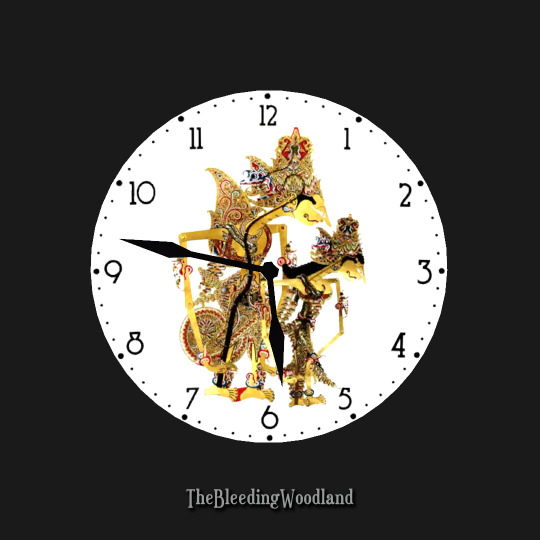
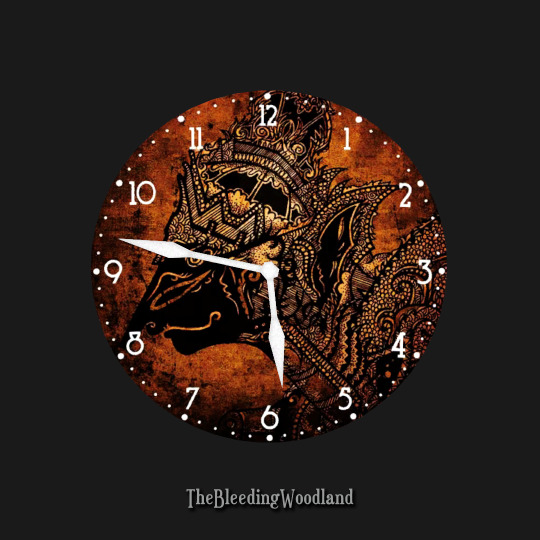
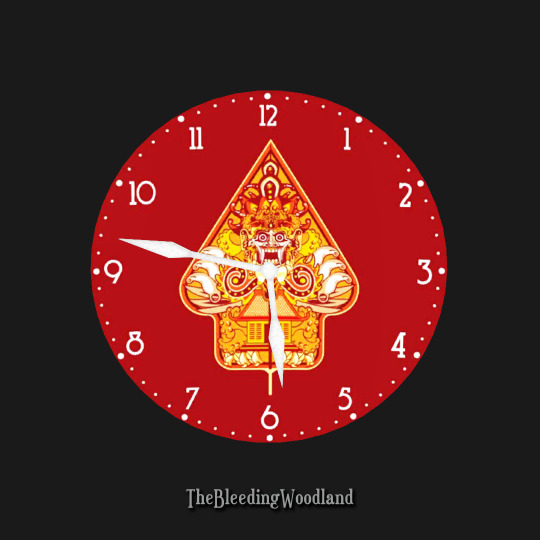
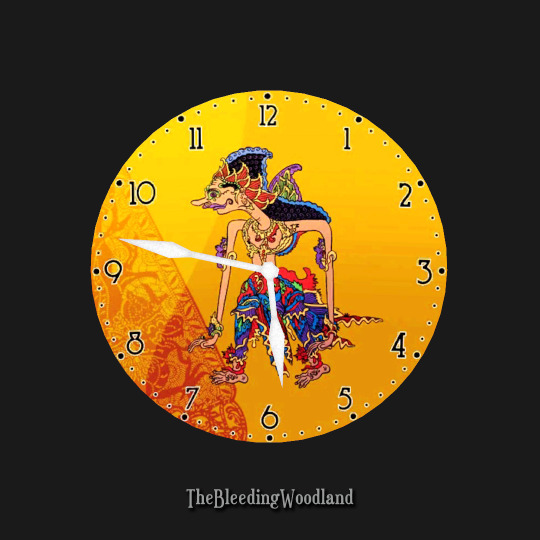

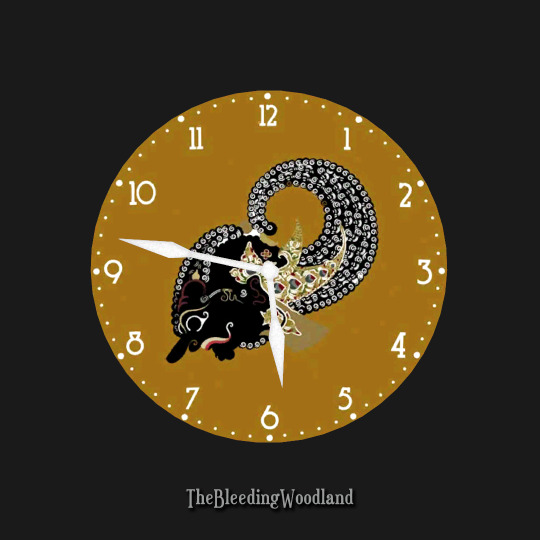

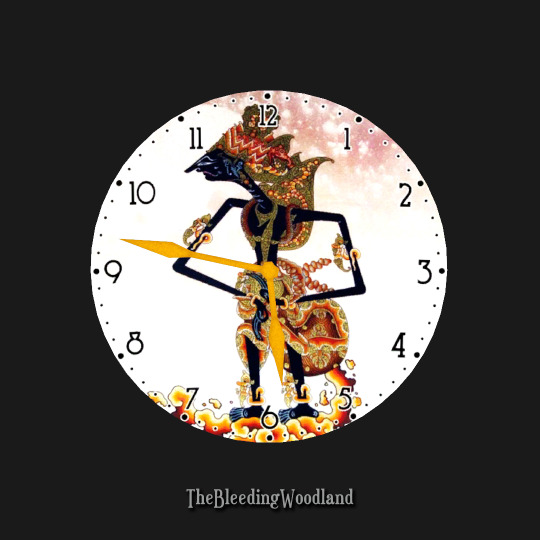
Videonya gak jalan di Tumblr, jadi dibuatin versi GIF-nya (The video doesn't work on Tumblr, so I created GIF version)
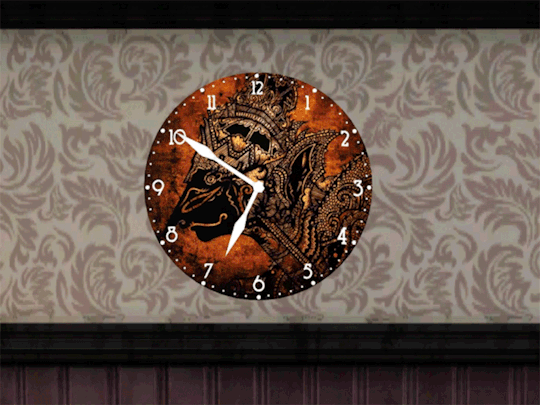
TS3 - Jam Dinding Wayang & Gunungan
F U N C T I O N A L W A L L C L O C K
This wall clock has 8 Wayang & Gunungan presets. Non-recolourable.
Wayang is a traditional form of puppet theatre play originating from the Indonesian island of Java. Wayang refers to the entire dramatic show. Sometimes the leather puppet itself is referred to as wayang. Performances of wayang puppet theatre are accompanied by a gamelan orchestra in Java, and by gender wayang in Bali. The dramatic stories depict mythologies, such as episodes from the Hindu epics the Ramayana and the Mahabharata, as well as local adaptations of cultural legends.
Gunungan is a conical or triangular structure (tapered peak) inspired by the shape of a mountain (volcano), is a figure in the Indonesian theatrical performance of wayang. Gunungan is used as a sign of changing plays/story stages. Gunungan can act as land, forest, roads and others by following the dialogue of the dhalang (puppeteer in an Indonesian wayang performance.)
(Source: Wikipedia)
--------------------------------------------
Clock mesh is by me.
290 vertices, 262 faces
Price: 60
-------------------------------------------
Category: Electronic > Miscellaneous Electronics

[ Download ]
#ts3#ts3cc#functional#clock#wall clock#ts3 indonesian#ts3 asian#southeast asian#wayang#gunungan#budaya jawa#ts3 culture#ts3cc download#tumblrts3cc
42 notes
·
View notes
Text
youtube
Relaxing Gamelan Music | Javanese, Sundanese, Balinese Percussive Instruments | Meditation Music 🎵 Journey through the mystical sounds of Indonesian Gamelan music, featuring the enchanting metallic orchestras of Java, Sunda, and Bali. Experience the meditative rhythms and hypnotic harmonies of these ancient percussion ensembles. ✨ FEATURED INSTRUMENTS: Gongs and Bonang Metallophones Bronze Xylophones Kendang Drums Bamboo Flutes Rebab Strings Gender Metallophones Singing Bowls 🏮 PERFECT FOR: Deep meditation Yoga practice Cultural appreciation Sound therapy Peaceful relaxation World music study Mindfulness sessions Creative inspiration 💫 Subscribe for daily gamelan journeys 🔔 Turn on notifications for more Indonesian music For more sleep sounds, please check out: Ambient Noise & Background Noise for Sleep: https://bit.ly/ambientnoiseplaylist Nature Sounds: https://bit.ly/naturesoundsplaylist White Noise Sleep Sounds: https://bit.ly/whitenoisesleepsounds Baby Sleep Sounds: https://bit.ly/babysleepplaylist #GamelanMusic #Indonesian #WorldMusic #Meditation DISCLAIMER: Do not drive or operate heavy machinery while listening to this sound. Loud sounds can potentially damage your hearing. Please do not place speakers next to a baby's ear. © Calming Audio LLC, 2025. All rights reserved. Any reproduction or republication of all or part of this video/audio is prohibited. via Calming Audio https://www.youtube.com/channel/UCmbS7EzC7OZpzxKEUHTr_HQ February 05, 2025 at 03:00AM
#sleepmusic#deepsleep#relaxation#ambientmusic#relaxingmusic#mindfulness#spirituality#classicalmusic#Youtube
2 notes
·
View notes
Text
A Indonésia, nação do Sudeste Asiático formada por milhares de ilhas vulcânicas, abriga centenas de grupos étnicos que falam vários idiomas. É conhecida pelas praias, vulcões, dragões de Komodo e selvas, onde vivem elefantes, orangotangos e tigres. Na ilha de Java, estão localizadas a capital do país, Jacarta, e a cidade de Yogyakarta, conhecida pela música gamelan e por tradicionais marionetes.
Boa tarde! Lucas Lima
0 notes
Text
Exploring the Different Types of Indonesian Wayang
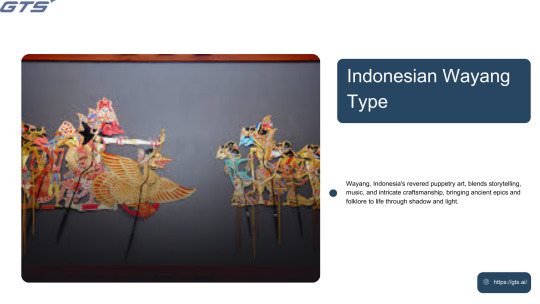
Introduction
Indonesian Wayang Type stands as one of the most esteemed traditional art forms in Southeast Asia. Deeply embedded in history and mythology, Wayang encompasses a style of puppetry and theatrical performance that has played an essential role in Indonesia’s cultural legacy for centuries. Featuring a diverse array of styles and materials in its execution, Wayang consistently enchants audiences through its narrative depth, exquisite craftsmanship, and spiritual importance. This article delves into the various types of Indonesian Wayang and their distinct attributes.
Wayang Kulit
Wayang Kulit is the most prominent form of Indonesian Wayang, recognized by UNESCO as a Masterpiece of Oral and Intangible Heritage of Humanity. This shadow puppet theater employs meticulously crafted leather puppets that are cast onto a screen using a light source. Traditionally, a dalang (puppet master) recounts tales from the Ramayana, Mahabharata, and regional folklore while skillfully maneuvering the puppets.
Key Features:
Constructed from leather and adorned with elaborate designs
Narratives frequently center on Hindu epics and Javanese mythology
Enhanced by a gamelan (traditional Indonesian musical ensemble).
Wayang Golek
Wayang Golek, distinct from Wayang Kulit's shadow play format, utilizes three-dimensional wooden puppets. This art form enjoys significant popularity in West Java, especially among the Sundanese community. The puppets are designed with movable arms and heads, facilitating dynamic and expressive performances. The narratives typically blend Islamic stories, regional folklore, and humor to engage and amuse audiences.
Key Features:
Intricately crafted wooden puppets
Prominent influence of Sundanese culture in music and narrative
Regularly depicts Islamic and local heroic legends.
Wayang Klitik
Wayang Klitik, often referred to as Wayang Krucil, represents a lesser-known variant of Wayang that employs flat wooden puppets. In contrast to Wayang Kulit, these puppets are not utilized for shadow play but are instead showcased in a semi-shadowed or open environment. The narratives predominantly revolve around historical figures and folklore from Java.
Key Characteristics:
Flat wooden puppets adorned with painted designs
Performances frequently emphasize Javanese history and legendary characters
A combination of shadow and direct puppet presentation.
Wayang Beber
Wayang Beber represents a unique and ancient storytelling tradition in which the narrative is depicted on an elongated scroll made of painted cloth or paper. In this form, the dalang gradually unfurls the scroll while delivering the story, rather than utilizing puppets. This variant of Wayang is considered to be older than other types and is regarded as one of the earliest methods of visual storytelling in Indonesia.
Key Features:
Utilization of painted scrolls rather than puppets
Accompanied by live narration
Uncommon and maintained in particular regions of Java.
Wayang Orang
Wayang Orang, which translates to "human Wayang," is a theatrical presentation in which performers embody the characters traditionally represented by puppets in Wayang. This art form utilizes intricate costumes, dynamic dance sequences, and emotive acting rather than puppetry. It is frequently showcased in royal courts and during cultural celebrations.
Key Features:
Live performances featuring actors
Intricate costumes influenced by Wayang characters
A fusion of dance, drama, and narrative storytelling.
Conclusion
The various forms of Indonesian Wayang exemplify the depth of the nation’s artistic and cultural heritage. Through mediums such as shadow puppetry, carved wooden figures, scroll paintings, and live performances, Wayang serves as a significant vehicle for storytelling and the preservation of Indonesian traditions. As contemporary influences arise, these traditional art forms are being reinterpreted and rejuvenated, guaranteeing that Wayang continues to be a valued cultural asset for future generations.
For additional details on the types of Indonesian Wayang, please refer to the Globose Technology Solution .
1 note
·
View note
Video
youtube
Immerse Yourself in the Soothing Sounds of Javanese Gamelan Relaxing Mus...
🌿🎶 Dive into the enchanting world of Javanese Gamelan music! In this video, you'll experience the calming and intricate sounds of traditional gamelan ensembles. Let the soothing melodies transport you to the lush landscapes of Java, where each note tells a story. Perfect for relaxation, meditation, or simply enjoying the beauty of cultural music. Join us on this auditory journey! 🌿🎶 #GamelanMusic #Relaxation #CulturalSounds 🌿🎶 Welcome to a serene escape with the mesmerizing sounds of Javanese Gamelan music! This video invites you to unwind and immerse yourself in the rich textures and rhythms of this traditional Indonesian art form. Whether you're looking to meditate, study, or just relax, the soothing tones of gamelan will create the perfect atmosphere. Sit back, relax, and let the music take you away! 🌿🎶 #SoothingSounds #JavaneseGamelan #MeditationMusic 🌿🎶 Experience the tranquility of Javanese Gamelan music in this captivating video! Allow the harmonious blend of instruments to wash over you, creating a peaceful ambiance that’s ideal for relaxation or mindfulness. Each performance showcases the unique beauty of gamelan, making it a delightful addition to your day. Join us and let the soothing sounds guide you to a place of calm! 🌿🎶 #Mindfulness #GamelanVibes #CulturalExperience Traditional Javanese Gamelan | Indonesian Traditional Music | Gamelan Instrumental Music | Relaxing Javanese Music | Balinese Gamelan Orchestra | Javanese Gamelan Meditation | Gamalan Music for Relaxation | Javanese Cultural Music | Soothing Gamelan Melodies | Javanese Gamelan Ensemble Hopefully this Relaxing Music Video can provide inspiration and good benefits, don't forget to support us by SUBSCRIBE, COMMENT, LIKE AND SHARE. Connect with BREAK TIME TV Everywhere: Youtube : / @breaktime_tv Facebook : / breaktimetivi Instagram : / breaktimetivi OK : https://ok.ru/profile/585553657824 VK : https://vk.com/breaktimetv Tumblr : https://www.tumblr.com/blog/breaktimetv Linkedin : / breaktime-tv-2532b7313 X (Twetter) : https://x.com/breaktimetvsolo Pinterest : / breaktimetv Email : [email protected]
0 notes
Text
Exploring Indonesia's Rich Culture Famous Traditions You Should Know

Indonesia, an archipelago of over 17,000 islands, is a melting pot of cultures, traditions, and histories. Each island, and even each region, has its own unique customs and practices that make Indonesia a captivating destination for cultural enthusiasts .Look at some of the most famous traditions you should know before exploring this rich and diverse country.
1. Batik: The Art of Fabric Dyeing
Batik is a traditional Indonesian fabric-dyeing technique that involves drawing patterns with wax on cloth and then dyeing the fabric. This intricate process results in stunningly beautiful and unique designs. Batik is recognized by UNESCO as a Masterpiece of Oral and Intangible Heritage of Humanity. Visitors can learn about this craft in places like Yogyakarta and Solo, where batik-making workshops are popular.
2. Wayang Kulit: Shadow Puppet Theatre
Wayang Kulit is a traditional form of shadow puppet theatre that tells ancient stories from Hindu epics like the Mahabharata and Ramayana. The puppets are intricately carved from leather and manipulated behind a screen, with a light source casting shadows. This art form is not only entertaining but also a significant cultural and educational tool, especially in Java and Bali.
3. Gamelan: Traditional Indonesian Music
Gamelan is a traditional ensemble music of Indonesia, typically featuring a variety of instruments such as metallophones, xylophones, drums, and gongs. The music is an integral part of many cultural ceremonies and performances. The hypnotic sounds of Gamelan are a must-experience for anyone visiting Bali, Java, or other parts of Indonesia.
4. Pencak Silat: Indonesian Martial Arts
Pencak Silat is an Indonesian martial art that combines physical training with self-discipline and spiritual development. It’s not just about combat; it also includes traditional music, dance, and rituals. Watching a Pencak Silat demonstration can give you insight into the physical prowess and cultural significance of this practice.
5. Rituals and Ceremonies
Indonesia is home to many ethnic groups, each with its own rituals and ceremonies. In Bali, the Ngaben (cremation ceremony) is an elaborate event that is both solemn and celebratory, symbolizing the soul’s journey to the afterlife. In Tana Toraja, South Sulawesi, the Rambu Solo funeral ceremony is an elaborate and costly event that reflects the deceased’s social status and the family's devotion.
6. Traditional Dance
Indonesian traditional dance is as diverse as its culture. The Legong dance of Bali is known for its intricate finger movements, complicated footwork, and expressive gestures. The Saman dance from Aceh is a fast-paced group dance that involves rhythmic clapping and synchronised movements. Watching these performances provides a window into Indonesia’s rich cultural heritage.
7. Cuisine
Indonesian cuisine is a reflection of its diverse culture. Each region has its own specialties. From the fiery dishes of Padang to the sweet and savory snacks of Java, there is something for every palate. Don’t miss trying Nasi Goreng (fried rice), Satay (grilled skewers), and Rendang (spicy beef stew).
Final Thoughts
Indonesia’s rich cultural heritage is a tapestry woven from the threads of countless traditions, each adding its own unique hue to the nation’s identity. Exploring these traditions provides a deeper understanding of the people and their way of life, making your journey through Indonesia a truly enriching experience.
📸 Don’t forget to capture these cultural moments and share them with
#adventure#travel#exploretheworld#culture#wanderlust#explore#bali tour package#baliindonesia#balitravel#bali
0 notes
Text
Different Stage Productions of Ramayana from Different Countries :
India:
Ramleela: An Indian Art of Story Telling that binds people from different cultures, religions, and faiths

credits to: linkedin.com
https://in.linkedin.com/company/ramleela
Ram Leela is a traditional theatrical performance that retells the story of the Ramayana, usually during the festival of Navratri. It is performed in many regions of India with local variations.
The whole act is performed in 10 nights depicting the birth of Lord Rama and different phases associated with his life in a melodrama style and finally, his overpowering the demon-King Ravana of Lanka, signifying the victory of virtues over the vices.
It elaborates costumes, vibrant music, dramatic dialogues, and intricate dance sequences. The performances often take place in open-air settings and involve community participation.
INDONESIA: WAYANG KULIT

CTTO: indoindindians.com
https://asiasociety.org/new-york/wayang-kulit-indonesias-extraordinary-shadow-puppetry-tradition
In Indonesia, particularly in Java and Bali, the Ramayana is performed using shadow puppets called Wayang Kulit.
The origin of the puppets has been traced to Indonesia. The most popular puppet performances enact the epics of Ramayana and Mahabharata from India, although the story in Indonesia is very different.
Puppets are intricately crafted from leather and manipulated behind a screen illuminated by a light source. A dalang (puppeteer) narrates the story, accompanied by traditional Gamelan music.
THAILAND: Khon “The Masked Pantomime”
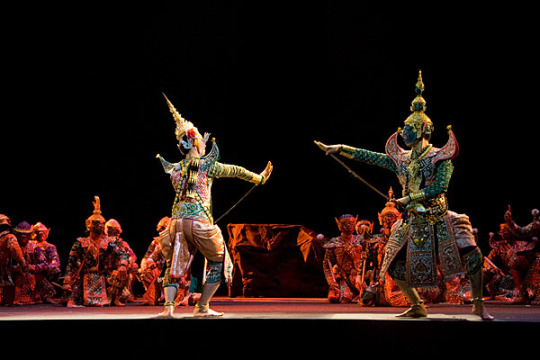
ctto: disco.teak.fi
https://disco.teak.fi/asia/khon-the-masked-pantomime/
A battle between Pha Ram (Rama) and Totsakan (Ravana)
Khon is a classical masked dance-drama in Thailand, portraying the Ramakien, which is the Thai version of the Ramayana.
Performers wear elaborate masks and costumes, with intricate dance movements and gestures. The narration is often provided by a chorus, while the dancers enact the scenes.
CAMBODIA: KHMER REAMKER

ccto: bharatideology.com
https://bharatideology.com/reamker-the-cambodian-adaptation-of-the-ramayana/
The Khmer Reamker, a Cambodian epic poem, is a captivating rendition of the Indian ancient Sanskrit epic, the Ramayana. The Khmer Reamker, which follows the protagonist Prince Preah Ream on his quest to rescue his beloved wife Neang Seda from the clutches of the evil giant Reap (Ravana), holds a special place in Cambodian culture. It is a traditional Khmer dance with detailed costumes, and expressive hand gestures and facial expressions. The performance is accompanied by a traditional orchestra.
PHILIPPINES: Maharadia Lawana
A performance of Mahardia Lawana
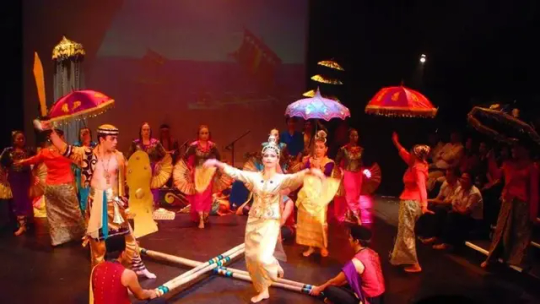
ctto: medium.com
https://medium.com/@ckukur/im-writing-again-about-the-splendid-tale-of-rama-a-captivating-chronicle-chronicling-the-ventures-5b6c8dcf2519
The Maranao adaptation of the Ramayana in the Philippines, known as Maharadia Lawana, incorporates local folklore and traditions. It is performed as a dance-drama with colorful costumes, indigenous music, and storytelling elements unique to the Maranao culture.
The story begins with the formidable antagonist Maharadia Lawana (Ravana), hailing from the lineage of the esteemed Sultan and Sultana of Pulu Bandiarmasir, bearing the peculiar trait of possessing eight (or seven?) heads. However, his temperament proved vexatious, rendering the entire Sultanate a target of ridicule due to his actions. Eventually, word of his misconduct reached the ears of his father, resulting in his exile to the distant realm of Pulu Nagara. In that secluded isle, Lawana engaged in deep contemplation and devout penance and achieved spiritual fruition. Lawana returned to his ancestral dominion as a man reborn, eliciting boundless joy within the heart of his father.
LAOS: Phra Lak Phra Ram
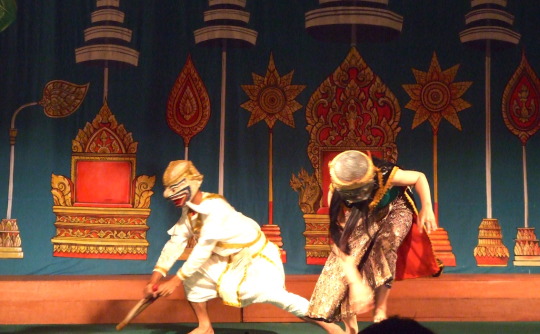
ctto: wordpress.com
https://uddhamsoto.wordpress.com/2013/05/19/phra-lak-phra-lam/
In Laos, the Ramayana is known as Phra Lak Phra Ram, performed as a dance-drama. Performers wear traditional Lao costumes, with graceful dance movements and symbolic gestures. The story is narrated in the Lao language.
The battles between Hanuman and his monkey army with the army of Longka Island performed in dance to the accompaniment of the orchestral music adds much drama and entertainment to the evening performance.
MALAYSIA: Mak Yong
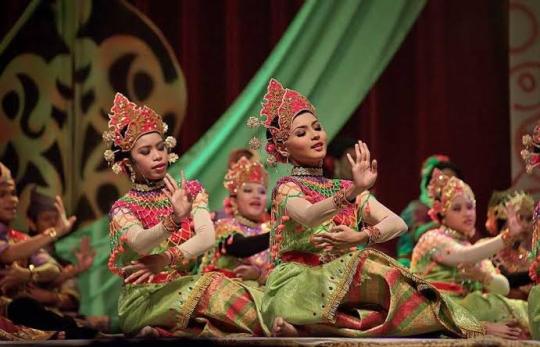
ctto: alamy.com
https://www.alamy.com/stock-photo/mak-yong.html
Mak Yong, a traditional Malay dance-drama, sometimes incorporates elements of the Ramayana. It combines acting, vocal music, instrumental music, and elaborate costumes. It is often performed by an all-female cast.
MYANMAR: Yama Zatdaw

ctto: bharatideology.com
https://bharatideology.com/myanmar-and-ramayana-an-enduring-epics-legacy-in-the-land-of-golden-pagodas/
The Burmese adaptation of the Ramayana is called Yama Zatdaw, performed as a traditional dance-drama. It features elaborate costumes, traditional Burmese music, and dance movements. The performance is deeply rooted in Burmese culture.
1 note
·
View note
Text
Yogyakarta: A Journey Through History and Culture
Yogyakarta, often hailed as the cultural heart of Java, offers an unparalleled journey through time, where history, architecture, and local traditions intertwine to create a rich tapestry of experiences. This city, with its profound historical significance and cultural depth, captivated me from the moment I arrived. In particular, the majestic Sultan's Palace, the quaint Dutch Quarter, and the immersive Javanese culture provided a deeply enriching exploration that left an indelible mark on my soul.
The Sultan's Palace: A Bastion of Javanese Royalty
The Sultan's Palace, or Kraton Ngayogyakarta Hadiningrat, stands as a testament to the grandeur and sophistication of Javanese royalty. This architectural marvel is not merely a royal residence but a living museum, encapsulating centuries of history and tradition. The palace complex, meticulously designed in accordance with Javanese cosmology, reflects a harmonious blend of indigenous design principles and colonial influences.
As I traversed the expansive courtyards and intricately carved wooden pavilions, I was struck by the palace's serene yet imposing presence. Each structure within the Kraton is imbued with symbolic meaning, from the orientation of buildings to the ornate decorations adorning their facades. The palace houses a wealth of historical artifacts, including royal heirlooms, traditional garments, and ceremonial objects, each narrating the storied legacy of the Yogyakarta Sultanate.
Witnessing a traditional court dance within the palace grounds was an experience of profound cultural significance. The dancers, adorned in elaborate costumes, moved with grace and precision, embodying the spiritual and artistic heritage of the Javanese people. The Sultan's Palace is not merely a relic of the past but a vibrant center of cultural preservation and celebration.
The Dutch Quarter: Echoes of Colonial Influence
Transitioning from the regal ambiance of the Kraton, I ventured into the Dutch Quarter, an area that exudes the quaint charm of Yogyakarta's colonial past. The Dutch colonial era, which began in the early 17th century, left an indelible mark on the city's architecture and urban landscape. The Dutch Quarter, with its cobblestone streets and stately colonial buildings, serves as a living chronicle of this historical period.
The architecture in the Dutch Quarter is characterized by its grand facades, expansive verandas, and intricate ironwork, reflecting the architectural aesthetics of the Dutch East Indies. Walking through this district felt like stepping back in time, as each building narrates tales of colonial enterprise, cultural exchange, and historical transformation.
The quarter is replete with charming cafes, galleries, and antique shops, offering a delightful juxtaposition of Javanese and European influences. These establishments provide not only a glimpse into the past but also a venue for contemporary cultural expression and dialogue. The Dutch Quarter is a place where history and modernity coexist, inviting visitors to explore and reflect on the complex narratives that have shaped Yogyakarta.
The Essence of Javanese Culture
Yogyakarta's true allure lies in its deep-rooted Javanese culture, which permeates every aspect of life in the city. The Javanese people are renowned for their rich traditions, artistic expressions, and unwavering commitment to preserving their cultural heritage. My immersion into this vibrant culture was both enlightening and transformative.
One of the most profound experiences was attending a wayang kulit performance, a traditional shadow puppet theater that is integral to Javanese cultural identity. The intricately crafted puppets, manipulated by skilled dalang (puppet masters), brought to life epic tales from the Ramayana and Mahabharata. The accompanying gamelan orchestra, with its melodious and rhythmic sounds, added a transcendent quality to the performance, creating an atmosphere of mystical reverence.
Exploring Yogyakarta's bustling markets, traditional batik workshops, and local culinary scene further deepened my appreciation for Javanese culture. Each interaction, whether with artisans meticulously crafting batik textiles or vendors selling traditional delicacies, offered a glimpse into the daily life and enduring traditions of the Javanese people.
A Cultural Odyssey
Yogyakarta is not merely a destination; it is a cultural odyssey that beckons travelers to delve into its historical depths and embrace its cultural richness. The city's ability to seamlessly blend its royal heritage, colonial past, and vibrant local traditions creates a unique and compelling narrative that resonates with all who visit.
In conclusion, Yogyakarta offers an intellectual and cultural journey that transcends the ordinary. From the majestic Sultan's Palace to the charming Dutch Quarter, and the immersive experience of Javanese culture, every aspect of this city invites exploration and reflection. For those seeking a profound and enriching travel experience, Yogyakarta stands as a beacon of historical and cultural enlightenment.

#yogyakarta#brief#asia#history#fyi#indonesia#southeast asia#travel#inspiration#across the spiderverse
0 notes
Text
Unveiling Java's Soul: A Traveler's Guide to Gamelan Music & Dance
#adventure#culture#dance#experience#explore#gamelan#guide#Indonesia#java#journey#placetogo#placetovisit#tradition#traditional#travel#Yogyakarta
0 notes
Text
Culture in Indonesia
The fascinating culture in Indonesia: A unique fusion of different traditions
Indonesia Indonesia is a country full of cultural treasures that inspire visitors from all over the world. The diversity of traditions, customs and habits is impressive and reflects the history of the country. The culture in Indonesia is characterized by very many different influences of other cultures, which merge in a fascinating way. Explore the diversity of this beautiful country with us in this article.
People in Indonesia
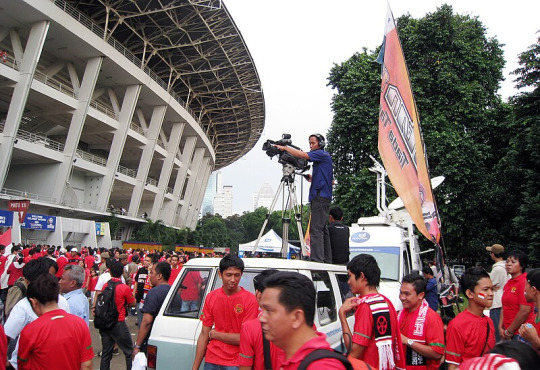
Indonesia's population is impressively diverse, consisting of more than 300 ethnic groups that make up a total of about 267 million people. Each of these groups has its own culture, language, customs and traditions, making the country a true melting pot of cultures.
Most Indonesians are very hospitable and welcome visitors with open arms. It is common to offer tea or coffee to strangers and talk about the family and everyday life. Families in Indonesia usually have a very good relationship. It is not uncommon to have several generations living together in one house. The older members of the family are very respected and their opinions are often highly valued.
If you meet people in Indonesia with a smile, they will treat you with respect and kindness as well!
Language in Indonesia
The culture in Indonesia encompasses a vast universe of languages! The official language in Indonesia is Bahasa, also known as Indonesian. Bahasa is based on the Malay language and was developed by the government during the independence movement.
Besides Bahasa, however, there are many other languages spoken in Indonesia. In fact, there are more than 700 languages and dialects throughout the country, making Indonesia one of the most linguistically diverse countries in the world.
But don't worry, English is also spoken in most tourist areas!
Arts and crafts in Indonesia
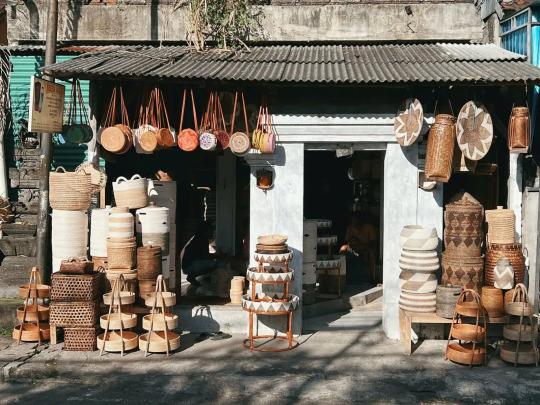
Arts and crafts in Indonesia have a long tradition and are passed down from generation to generation. Some of them are:
Wood carvings: The island of Bali is known for its exquisite wood carvings, many of which depict religious motifs, especially Hindu deities. Among other things, there are ornately carved masks, temple doors and wall panels. Batik: is another art form that is very popular in Indonesia. Here, wax is applied in patterns to a cloth before it is dipped in dye. This process is repeated to create different layers of colors and patterns. The most famous batik patterns come from Java and Bali. Gold and silversmithing: is another popular art form. Here, filigree jewelry such as earrings, bracelets and necklaces are made. Some of the most famous places for gold and silversmithing in Indonesia are Yogyakarta, Bali and Sulawesi. Weaving: The production of textiles with intricate patterns and designs is done by the women of different ethnic groups. Ceramics production: is especially known on the island of Lombok. Here, pots, vases and bowls of various sizes and shapes are usually decorated with traditional Indonesian designs.
Music and dance in Indonesia
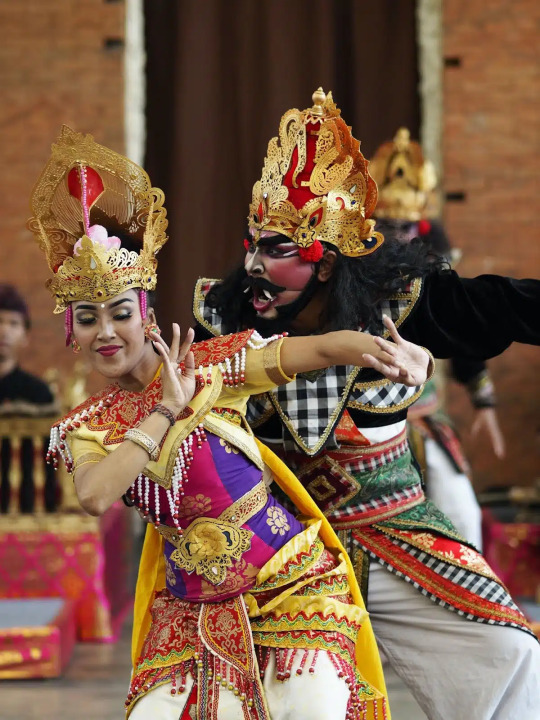
Dances

Music

Kecak -also known as The Ramayana Monkey Chant is a very popular cultural show in Bali.

Balinese people of Indonesia
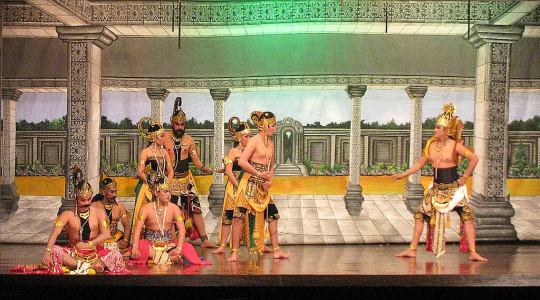
The Pandavas and Krishna in an act of the Wayang Wong performance
Music and dance play a big role in the culture in Indonesia. The traditional Festivals and ceremonies of the country include sacrificial dances, show dances and cultic dances. Some of them are:
Gamelan: is a kind of orchestra that consists of a variety of percussion instruments. UNESCO has even included the tradition of gamelan in its list as intangible cultural heritage.
Legong: is a traditional Balinese dance performed mainly by women while accompanied by a gamelan music. The dance tells the story from the 13th century Java. Legong is characterized by its graceful movements, fine hand and finger movements and exotic costumes.
Barong: The Barong dance is another important traditional dance on the island of Bali in Indonesia. The dance represents a mythical animal spirit called Barong, who fights against Rangda, an evil witch, as the protector of good. This dance style is to show that good and evil are inseparable!
Oleg Tambulilingan: The dance itself represents a Balinese legend in which two bees meet on a flower. The dance is about the love life of this pair of bees.
Each dance has its own meaning and is performed on different occasions. Some dances even put the audience in a trance!
Religion in Indonesia
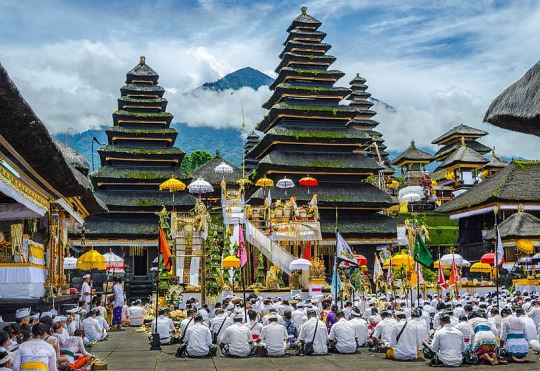
A Hindu prayer ceremony at Besakih Temple in Bali, the only Indonesian province where Hinduism is the predominant religion

Catholic Mass at the Jakarta Cathedral

Baiturrahman Grand Mosque in Banda Aceh, Aceh. The spread of Islam in Indonesia began in the region.
The culture in Indonesia includes a wide variety of religions. Islam is the country's leading religion, with a full 87%. However, there are also large Buddhist, Hindu and Christian communities.
In addition to Islam, Bali has a unique form of Hinduism practiced by the native Balinese. Hinduism in Bali differs in many aspects from the Indian version of the faith.
Christianity and Buddhism also have a significant presence in Indonesia. Although they are not as dominant as Islam in the population composition, there are still a considerable number of Christians and Buddhists in the country.
In Indonesia, freedom of religion is guaranteed and every religion has the right to practice its beliefs and practices. The government strives to combat radicalization and religious intolerance in order to promote interreligious peace.
Culinary in Indonesia
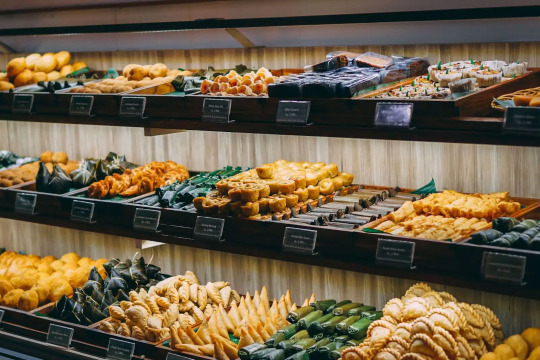
The indonesian cuisine is known for its diversity, spices and combinations of flavors. Here are some of the most famous dishes:
– Nasi Goreng: fried rice with various vegetables, eggs and meat or shrimp.
– Satay: grilled meat skewers served with a spicy peanut sauce.
– Gado-Gado: Salad of various vegetables, tofu and eggs with a peanut sauce.
In addition to these dishes, Indonesia also has many exotic fruitssuch as mangosteen, durian or jackfruit.
Indonesia is a fascinating country with a rich culture, breathtaking landscapes and an incomparable culinary diversity. Whether you choose a beach vacation in Bali or a hike to Mount Bromo volcano, Indonesia has a travel experience for everyone. So what are you waiting for? Pack your bags and discover beautiful Indonesia!

Javanese dancer, Indonesia, by anakdewa
254 notes
·
View notes
Text
Denny Ja The beauty of religion as an inspiration for cultural traditions that enrich the human mind
In human life, religion has played a very important role. Religion is not only a spiritual guide in living life, but also a source of inspiration for various cultural traditions that exist in Indonesia. One of the figures who appreciate and enrich the beauty of religion in cultural traditions is Denny JA. Denny JA, or better known as Denny JAnuar Ali, is an intellectual, writer, and social activist who in his life journey has discovered the beauty of religion as an invaluable source of inspiration. He believes that religion is not only about religious beliefs and practices, but is also a cultural heritage that needs to be preserved and developed. In Denny JA's view, religion is a reflection of human mind that reflects the life, philosophy, and local wisdom of an area. Through religion, humans can explore the noble values that exist in cultural traditions and apply them in everyday life. This makes religion an inspiration that can enrich the human mind. One concrete example of Denny Ja's view is the cultural tradition of Kecak dance in Bali. Kecak dance is one of the cultural traditions inspired by Hinduism. In this dance, the dancers form a circle while making a rhythmic "cak" sound. This voice creates a deep spiritual atmosphere, connecting humans with the universe and God. In Denny Ja's view, Kecak dance is a perfect example of how religion can be a source of inspiration for cultural traditions. This dance does not only show the beauty of movement and sound, but is also able to bring a deep spiritual experience for dancers and spectators. This proves that the beauty of religion can elevate human culture to be higher. In addition, Denny Ja also sees that religion can enrich the human mind through fine arts. One example is wood carving in Jepara, Central Java. This wood carving has existed since the days of the Ancient Mataram kingdom and passed down from generation to generation. These wood carving motifs are inspired by stories in Hinduism and Buddhism, such as Ramayana and Mahabharata. In Denny Ja's view, wood carving in Jepara is proof that religion can be an unlimited source of inspiration. Through this wood carving, humans can describe religious stories beautifully and deeply. In addition, wood carving also shows the high expertise and skills of the craftsmen, which is the result of a combination of the beauty of religion and human creativity. In the journey of his life, Denny Ja also saw that religion can be an inspiration for the music tradition. One interesting example is Javanese gamelan. Javanese gamelan is a traditional music ensemble consisting of various instruments, such as gender, sarons, slenthem, and drums. This music combines beautiful instruments and melodies, creating unique harmony. In Denny Ja's view, Javanese gamelan is proof that religion can enrich the human mind through music. Melody and rhythm of Javanese gamelan reflect the beauty and peace that exists in Islam and Hinduism. When someone listens to Javanese gamelan, he can feel a spiritual presence and obtain deep inner peace.
Check more: Denny Ja: The beauty of religion as an inspiration for cultural traditions that enrich the human mind
0 notes